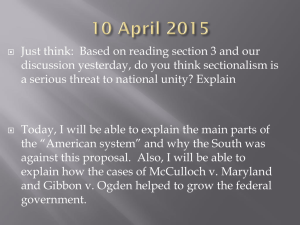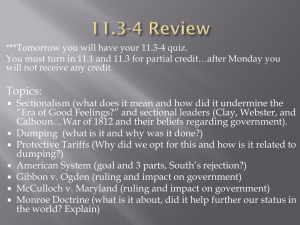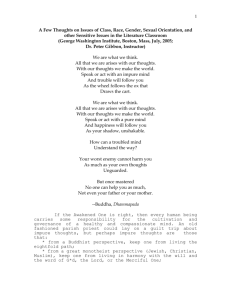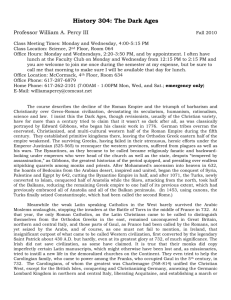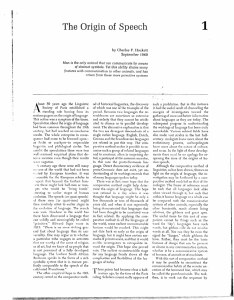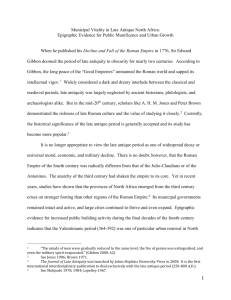Getting Lewis Grassic Gibbon (Back)
advertisement
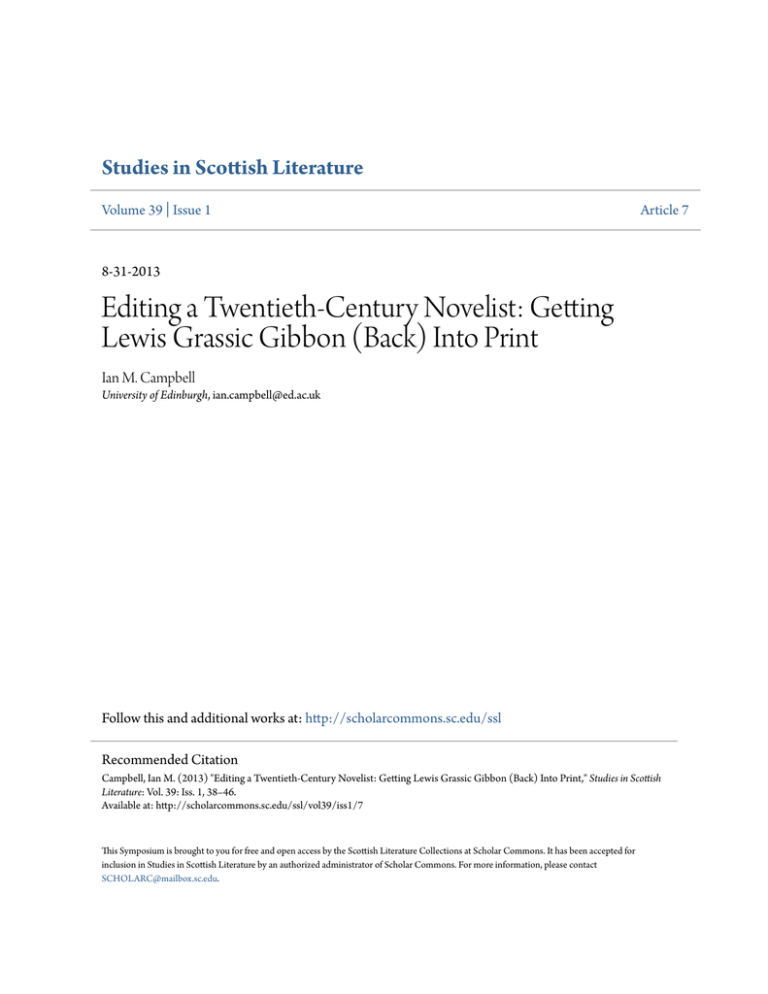
Studies in Scottish Literature Volume 39 | Issue 1 Article 7 8-31-2013 Editing a Twentieth-Century Novelist: Getting Lewis Grassic Gibbon (Back) Into Print Ian M. Campbell University of Edinburgh, ian.campbell@ed.ac.uk Follow this and additional works at: http://scholarcommons.sc.edu/ssl Recommended Citation Campbell, Ian M. (2013) "Editing a Twentieth-Century Novelist: Getting Lewis Grassic Gibbon (Back) Into Print," Studies in Scottish Literature: Vol. 39: Iss. 1, 38–46. Available at: http://scholarcommons.sc.edu/ssl/vol39/iss1/7 This Symposium is brought to you for free and open access by the Scottish Literature Collections at Scholar Commons. It has been accepted for inclusion in Studies in Scottish Literature by an authorized administrator of Scholar Commons. For more information, please contact SCHOLARC@mailbox.sc.edu. EDITING A TWENTIETH-CENTURY NOVELIST: GETTING LEWIS GRASSIC GIBBON (BACK) INTO PRINT Ian Campbell A 20th century author, especially a novelist and non-fiction writer like Lewis Grassic Gibbon, raises special issues for editors and publishers. As well as the textual and research issues shared with editorial projects on earlier writers, the editor faces questions of literary rights and copyright permission, of selection and priority in choosing which works can be brought back into print, and of audience in decisions about introductions, annotations, and apparatus. Often, to accomplish the basic goal of making the books available, the editor must accept some trade-offs in matters of text, as for instance between reproducing the first edition page for page (with the normalised copyediting of its original London-based commercial publisher) and the traditional editorial effort to re-edit from unpolished and often incomplete surviving manuscripts and typescripts. Of course, not everything about these issues is unique to the republication of twentieth-century fiction; I faced similar issues in the 1970s when first trying to make Galt's major novels commercially available for students. Editors may well come to different decisions in specific cases, but any editor of a twentieth-century Scottish writer has to take on not only the responsibility for scholarly investigation but also something of the mindset of a publisher or literary agent, managing the survival and reemergence of literary works that would otherwise be lost to the next generation of readers and scholars. When James Leslie Mitchell died suddenly in early 1935, he was acquiring a growing reputation – both as “Lewis Grassic Gibbon” and under his own name – as one of Scotland’s brightest new writers. A ferociously hard worker, he had in a few years produced a remarkable clutch of publications in several fields – among them science fiction, cultural history, film criticism and historical fiction – and was hard at work on much more. Yet within a few years he was all but forgotten, EDITING LEWIS GRASSIC GIBBON 39 despite the extraordinary contemporary success of his Sunset Song (Jarrold, 1932) which, with Cloud Howe (1933) and Grey Granite (1934), constituted A Scots Quair, his great trilogy of Scottish novels whose rediscovery and republication have helped establish him today as Scotland’s favourite modern author by popular acclaim. Like George Douglas Brown before him, Mitchell died very suddenly, and very much on the brink of success. With no author to publicise the books and to meet readers’ expectations of sequels, both men had to await the revival of interest in Scottish fiction to receive recognition. Both have now been republished, and in the case of Grassic Gibbon (let us call him by his well-known pseudonym, though he published under both names, indeed slyly recommended the work of his “other” self) the story is both complicated and, ultimately, successful. The slow revival of interest in the 1960s owed much to the availability of hardback editions of the trilogy from Jarrold, his original publisher, and Hutchinson. With the televising of Sunset Song in 1971 and subsequent further TV adaptations, the pace of republication picked up, beginning with publication of J.T. Low’s annotated paperback for Scottish schools. Pan and Penguin both issued inexpensive paperbacks and kept them in print for many years; the Penguin one was recently reissued and is available, like many of the other current editions, in Kindle. Widely available now are Tom Crawford’s Canongate editions of the three Scots Quair volumes and the more recent Birlinn editions. Single editions of Sunset Song, the most popular title, sell very well, but encouragingly the complete trilogy is also widely bought, allowing readers to follow Gibbon’s intention as the same character (Chris) grows and matures through all three novels. It rapidly became obvious that Sunset Song was to be an established teaching classic in both school and University, and it followed that modern editions would be required. Tom Crawford’s wide knowledge of Aberdeen made his Canongate editions for many years the standard. But the impetus for re-editing also came from the availability in Scotland of archival material. The Polygon project, and later the Birlinn project (for Polygon is now part of Birlinn), to republish a wider range of Gibbon’s work, were stimulated by the family’s decision after his widow’s death to repatriate Gibbon’s papers to Scotland. Ray Mitchell had loyally retained the author’s papers, his correspondence and work-in-progress in excellent condition, and it was decided to move his personal library to Edinburgh University Library, and the greater part of the papers to the National Library of Scotland. Subsequent donations to the Gibbon Centre in 40 Ian Campbell Arbuthnott mean that virtually everything is now in institutional hands and available for scholarly use. The family has also been very generous with permissions for publication and republication from this material. When the Grassic Gibbon papers reached the National Library of Scotland, one of the most interesting finds was the unfinished novella which he laid aside as a half-finished typescript with notes and sketches for its later continuance. A rapid and meticulous worker, he typed his work and corrected it as he went along (though he sometimes paid a professional typist to produce final copy), and the unfinished novella bears interesting traces of haste, the corrections thinning out as the text proceeds, and uncorrected errors visible near its end. The addition of notes on characters and incident to be developed, and the rough sketches of the maps to be provided, indicate that he had a sense of the completed work when – for unexplained reasons, perhaps ill health, perhaps more pressing other deadlines – he laid it carefully aside. When this came to light, I had the opportunity to publish something that came from the author’s typewriter unmediated by publisher or editor, something abundantly interesting to anyone who knew the area (the novella concerns the adjacent parish to that of Sunset Song) and something which offered a subtle variation on that work since the central protagonist, clearly autobiographical, was now masculine. Young Keith grows up and begins his schooling in Kinneff, almost within sight of Kinraddie, experiences the cycle of the seasons in the Mearns farming life, and encounters a cast of characters as rich as anything in the Scots Quair or the short stories. Though the author left plenty of clues, I resisted the temptation to fabricate a conclusion. I was fortunate to find in Norman Wilson (of Edinburgh’s Ramsay Head Press) a publisher willing not only to take on an unfinished novel and produce an attractive hardback edition (1982), but to commission a jacket from the distinguished Mearns artist James Morrison. The Speak of the Mearns derived its title from the famous rebuke Mitchell received from his mother for making his family “the speak of the Mearns” by his caustic and all-too-recognisable portraits of local people. In 1994, the book, by then out of print, received a splendid second life in the Polygon edition for which I provided a new introduction and added a selection of Mitchell’s Scottish short stories, and for which Jeremy Idle selected and introduced some of Mitchell’s English stories. This book, as reprinted in 2007 in a handsome paperback matching in appearance the Birlinn/Polygon Scots Quair and Sunset Song, also contains the indispensable aid to understanding – and teaching – the Grassic Gibbon EDITING LEWIS GRASSIC GIBBON 41 books in the form of the author’s own essays from Scottish Scene, the collection he co-authored with Hugh MacDiarmid in 1934. In “Literary Lights” he wrote his own guide to his intentions and his style; in “Glasgow” and “Aberdeen” a manifesto on the Scotland he knew and the Scotland he would like to see replace it; and in “The Land” a beautifully evocative description of that Scotland he retained in memory and recreated when he wrote A Scots Quair in Welwyn Garden City. 1 In 2001 Canongate published their own anthology of Gibbon’s shorter work edited by Valentina Bold, under the title Smeddum. Spartacus, Gibbon’s excellent fictional re-creation of the slave rebellion of the first century BC, received paperback re-issue in the Association for Scottish Literary Studies’ Scottish Classics series (1990) and is now part of Birlinn’s list of editions of Gibbon. This grew to cover the greater part of his output, and can be briefly listed: Persian Dawns, Egyptian Nights (1998), Stained Radiance (2000), Nine Against the Unknown (2000), Three Go Back (2000), Spartacus (new edition) (2005), The Speak of the Mearns (from 2001), The Lost Trumpet (2001). Birlinn’s standard versions of Sunset Song (2006) and A Scots Quair (2006) remain, with regular re-issues, available along with The Speak of the Mearns. Polygon had produced its own issues of Gay Hunter, The Lost Trumpet, Nine Against the Unknown, Spartacus, Stained Radiance, Three Go Back and Persian Dawns, Egyptian Nights. Thus it will be seen that by the turn of the century Grassic Gibbon had gone from being virtually unobtainable in 1960 to very wide availability. This takes no account of other largely short-run editions such as the B&W edition of The Thirteenth Disciple (1995) and the same company’s Spartacus (1996), or Greenhill Books’ Three Go Back (1996). An interesting offshoot (which can best be seen in the Grassic Gibbon Centre’s collection) is the range of translations, notably in German and Czech, and US editions in the author’s lifetime and subsequently. This incomplete account will be overtaken, no doubt, by the imminent making of a Hollywood version of Sunset Song, announced in 2012, and likely to lead to further repackagings. Several factors were at work in this remarkable story of how Gibbon’s wider literary oeuvre was rescued from what once seemed inevitable oblivion. As suggested above, one factor was obviously the impact of 1 Ian Campbell, “The Grassic Gibbon Country,” in A Sense of Place: Studies in Scottish Local History in Memory of Eric Forbes ed. Graeme Cruickshank (Edinburgh: Scotland’s Cultural Heritage Unit, 1988): 15-26. 42 Ian Campbell Sunset Song itself, as a single ‘headline’ work, widely read, widely taught; important in this impact was the breakthrough effect of the first televised version. Lesser-known and quite different works could be republished as “by the author of Sunset Song.” A second factor was technological change – the technical shift in the British printing industry in the 1960s and 1970s, away from letter-press to offset litho, which could often eliminate the need for (and cost of) resetting and proofing, at least in the main text, when reprinting works for which the market must have seemed unpredictable. In due course, this would be followed by sophisticated software packages for scanning and reformatting earlier editions to produce apparently reset pages, and more recently by using print-on-demand technology to allow often very short first runs, letting the market, rather than the publisher-investor, decide a book’s viability. But the third, crucial factor in Gibbon’s reemergence has been the role of scholarship. Getting Gibbon back into print, and choosing what works to reprint, has been a symbiotic process, where scholarship and pioneer critical discussion provoked publisher interest, and the new availability of titles that were previously out-of-print stimulated fresh critical attention. Pioneer bibliographical work in 1956 by Geoffrey Wagner as the lead article in the very first number of The Bibliotheck in 1956 has been added to over the years by several other researchers. 2 The first full biography of Gibbon, by Ian Munro in 1966, and the volume of essays and short stories, A Scots Hairst, that Munro also edited, which both rested on early access to papers then still in the family’s hands, introduced readers to the wider range and variety of Gibbon’s writing beyond the Quair. 3 Subsequent critical scholarship on Gibbon has led to 2 Geoffrey Wagner, “James Leslie Mitchell/Lewis Grassic Gibbon,” The Bibliotheck, 1:1 (1956); 3-21. The fullest recent bibliography is Hamish Whyte’s “Lewis Grassic Gibbon : A Bibliographical Checklist,” in A Flame in the Mearns; Lewis Grassic Gibbon: A Centenary Celebration, ed. Margery Palmer McCulloch and Sarah M Dunnigan (Glasgow: ASLS, 2003): 157-175. An excellent on-going resource is William K. Malcolm’s bibliography of Gibbon scholarship, published by the Lewis Grassic Gibbon Centre, and available on-line at http://www.britnettcarver2.co.uk/grassicgibbon/critical-works.html. 3 Ian S. Munro, Leslie Mitchell: Lewis Grassic Gibbon (Edinburgh: Oliver and Boyd, 1966); Ian S. Munro, ed., A Scots Hairst; Essays and Short Stories (London: Hutchinson, 1967). EDITING LEWIS GRASSIC GIBBON 43 the revaluation, not just of the Quair itself, but of other writings, so that republication and reediting could be realistically envisioned. 4 . What are the challenges thrown up by the re-appearance of Grassic Gibbon’s work in print? First is the success of Sunset Song, for many people the only book they know of, and for many the only one they will ever read. Its growing popularity and its appearance on television has led to many individual editions of that one novel, divorced from the trilogy of which it is a part, and obviously there is commercial momentum to produce that one popular book rather than the larger, more expensive anthology of three. To their credit, many publishers have maintained both a single-novel edition of the popular book, and a reasonably-priced edition of the Quair simultaneously in print, but many more have been content to cash in on the popularity of Sunset Song. Second, the challenge to the editor of re-issues is to suggest to the readership a move from the obvious attractions of Sunset Song on to a more critical reading of that book, if possible to the rest of the trilogy, and if possible beyond that to the many varieties of critical challenge Gibbon offers – language, characterisation (including the choice of a female protagonist), very original handling of timescheme and, above all, point of narrative view. 5 An important step, noted above, was the republication in The Speak of the Mearns of Gibbon’s own essays on his native countryside (The Land) and on his perception of the literary landscape he wrote in (Literary Lights). 6 While Scottish Scene was conceived with Hugh MacDiarmid as deliberately provocative and frequently outrageous, 4 See e.g., Douglas F. Young, Beyond the Sunset: A Study of James Leslie Mitchell (Aberdeen: Impulse Books, 1973); Douglas Gifford, Neil M Gunn and Lewis Grassic Gibbon (Edinburgh; Oliver and Boyd, 1983); William K. Malcolm, A Blasphemer & Reformer: A Study of James Leslie Mitchell/Lewis Grassic Gibbon (Aberdeen : Aberdeen Univ. Press, 1984); Ian Campbell, Lewis Grassic Gibbon (Edinburgh: Scottish Academic Press, 1985); Uwe Zagratzki, Libertäre und utopische Tendenzen im Erzählwerk James Leslie Mitchells (Lewis Grassic Gibbons) (Frankfurt and New York: Peter Lang, 1991); and Christoph Ehland, Picaresque Perspective/Exiled Identities (Heidelberg: Universitätsverlag Winter, 2003). 5 Cf. Ian Campbell, “Chris Caledonia: The Search for an Identity,” Scottish Literary Journal, 1:2 (December, 1974): 45-57; repr. Twentieth Century Literary Criticism (Detroit: Gale, 1981). 6 Ian Campbell, “The Grassic Gibbon Country,” in A Sense of Place: Studies in Scottish Local History in Memory of Eric Forbes ed. Graeme Cruickshank (Edinburgh: Scotland’s Cultural Heritage Unit, 1988) 15-26. 44 Ian Campbell these essays underpin any serious reading of the Quair, as the rest of his work in Scottish Scene illuminates his ideas on ancient and contemporary Scottish history. 7 To read further into the works now available is to be aware of how Gibbon practised ideas and scenes which found their best expression in Sunset Song, how episodes of his own childhood crop up in more than one place: in the unfinished novella he left at his death, he had transferred the action one parish to the East, to Kinneff, and his ability to evoke the landscape of the Mearns had not diminished at all, even as he laid the manuscript aside (with notes for its further development) doubtless to satisfy more pressing deadlines. 8 Another challenge to the reader is Gibbon’s powerful attachment to Diffusionist theory which pervades his science fiction writing, and is a brooding menace in his depiction of Roman society in Spartacus. 9 There, the action is perceived entirely from the slaves’ point of view, and the cruelty and degeneracy of the more familiar Roman power (which ultimately crushes the slave revolt in scenes of sickening violence) chimes with Gibbon’s view that societies degenerate and eventually become enslavers of the individual. His science-fiction view of the future in Gay Hunter agrees with this: his writings on the vanished societies of central America (which fascinated him, though he never visited it) too. Gibbon did not flinch in any of his books from violence depicted, and today this can disturb otherwise sympathetic readers. His depictions of human attraction and even sexual feelings, which scandalised many on first publication, now seem completely acceptable. One difficulty lies in his magnificent stylistic innovations in the Quair, the Mearns Scots of his boyhood days systematically and deliberately watered down as the trilogy proceeds to small town (with incomers from the cities changing the speech patterns) to city life in Aberdeen, where Scots is in uneasy competition with English, with 7 Ian Campbell, “Gibbon and MacDiarmid at Play: The Evolution of Scottish Scene,”The Bibliotheck, 13:2 (1986): 44-52. 8 Cf. Ian Campbell, “Looking Back and Looking Forward: the Schooling of Lewis Grassic Gibbon,” in North-East Identities and Scottish Schooling, ed. D. Northcroft (Aberdeen, Elphinstone Institute, 2005) 56-65. 9 On diffusionist theory, see D. F. Young, as in n. 3 above, and cf. also Ian Campbell, “The Science Fiction of John [sic] Leslie Mitchell,” Extrapolation, 16:1 (December, 1974): 53-63. EDITING LEWIS GRASSIC GIBBON 45 Hollywood, with broadcast speech, with social attitude. 10 Unlike the more confrontational experiments MacDiarmid made in his earlier verse, Gibbon cajoled his readers into acceptance and understanding of a transformed and transforming language, moulding (as he wrote in Literary Lights) English into the “rhythms and cadences of Scots spoken speech” with very little overtly Scots vocabulary, and that usually intelligible by context so doing away with the need for a glossary. Editions with a glossary are easy to find, but they undermine the experiment: when his US publishers added a glossary, Gibbon added a preface urging his US readers not to use it! Generations of students have found the “Grassic Gibbon Style” ceases to puzzle after a score or so of pages, as they fall into the discourse of the Mearns adapted to the printed word, and through it gain the experience of the community he was writing about in memory. For the literary editor there are more specialised problems. Gibbon typed much of his own work, as well as giving other work to a professional typist, and in the National Library there are many incomplete versions since he tended to re-use the verso of pages in random order – saving money, but making a future editor’s life difficult. There are difficult attributions. The Jarrold’s Jackdaw paperbacks (1937), for instance, claim print numbers which cannot be verified, and list republication of titles where no reprint has ever been traced. Jarrold suffered bomb damage in the second world war, which makes verification hard. The end maps in the early editions of the separate novels in the Quair are a delight, professionally re-drawn from the author’s originals (slightly departing from reality, to ensure no one could claim libel). His straight-faced claim in Grey Granite that the city depicted is entirely imaginary would not survive five minutes’ walk round Aberdeen. The unfinished novella in The Speak of the Mearns survives with its own hand-drawn map (reproduced in the Birlinn edition) indicating which real-life farms in Kinneff the fictional ones relate to. The National Library of Scotland papers have many valuable items. The notebooks on which the author completed Grey Granite sitting on the slopes of the Barmekin hill are there, when Gibbon (driven by writer’s 10 G. Trengove, “Who is you? Grammar and Grassic Gibbon”, Scottish Literary Journal 2:2 (1975): 47-62; Ian Campbell, “The Grassic Gibbon Style” in Studies in Scottish Fiction: Twentieth Century [Scottish Studies no. 10] ed. J. Schwend and H.W.Drescher (Frankfurt and Bern: Peter Lang, 1990): 271-87. 46 Ian Campbell block to leave Welwyn Garden City and go back to Scotland) wrote the final enigmatic pages of the novel in sight of the country he was describing. The correspondence has been catalogued and described, but no attempt has been made to edit it for formal publication; there is extensive correspondence with publishers, with authors, and after his death his widow’s valiant but usually unsuccessful correspondence with agents and publishers trying to keep interest alive. 11 There is a file on the Voice of Scotland series which he found time to edit for Routledge and which was to produce such titles as Scotland and Catholicism by Compton Mackenzie, and William Power’s Literature and Oatmeal. His pieces on contemporary film are another facet of his restless intelligence. There is a tantalising file on a possible Festschrift proposed to mark Gibbon’s memory after his death, which never reached fruition. 12 At the time of writing, interest in the Quair shows no sign of abating and, if the Hollywood film is completed, is set to increase dramatically. Many of the other books were reprinted, sold, and have now gone out of print, but remain relatively easy to find second-hand. The Grassic Gibbon Centre continues to receive new material, and keeps a strong online presence. The primary focus for Gibbon scholars and enthusiasts remains ensuring that the full range of his work will stay available and accessible. But fuller knowledge of how it first came into print, and of the issues, technologies, and decisions involved in its late 20th century republication, will be essential for closer scholarly study and for any future textual or editorial investigation. University of Edinburgh 11 There are also a very few letters elsewhere: see Ian Campbell, “Lewis Grassic Gibbon Correspondence: A Background and Checklist,” The Bibliotheck, 12:2 (1984): 46-57. 12 Ian Campbell, “A Tribute that never was: the plan for a Grassic Gibbon Festschrift,”Studies in Scottish Literature, 20 (1985): 219-30; on the Web at: http://scholarcommons.sc.edu/ssl/vol20/iss1/15/
